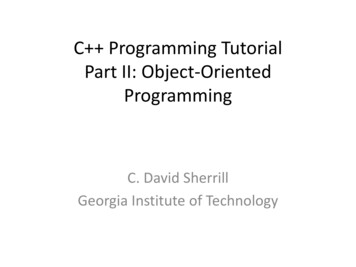
Transcription
C Programming TutorialPart II: Object-OrientedProgrammingC. David SherrillGeorgia Institute of Technology
Chapter 9: Introduction to Objects Declaring and Defining a Class Data encapsulation; public and private class members; getter/settermethods Pointers to classes Initializing data Constructors and default constuctors The “this” pointer Initialization lists Destructors Shallow and deep copies, copy constructors, and copy by assignment Intro to move constructors Classes that don’t allow copying, singleton classes Classes only creatable on the heap sizeof() a class Friend Functions and Friend Classes Const member functions
Introduction to ObjectsAn object is a user-defined datatype like aninteger or a string. Unlike those simpledatatypes, though, an object can have muchricher functionality. It typically collects somedata (“member data”) and some functionality(“methods”). For example, we might create aclass to handle a matrix, or a tensor, or astudent’s record in a class, etc.
Declaring and Defining a ClassBefore we can use variables of a given class, we first haveto specify the class. Analogous to functions, we candeclare the class by specifying any member data itcontains and providing a list of its available functions(along with what arguments those functions take andtheir return types). This is often done in a header file(whose name is typically the name of the class, with a“.h” suffix). We can then define the functions in theclass in another file if we like (often with the name ofthe class with a “.cc” suffix). Alternatively, some or allof the function definitions can also go in the header file(often this is done for short functions or inlinefunctions).
Example: The Student Class Suppose we want to keep track of studentstaking a course. Each student will have aname, a midterm grade, a final grade, and acourse project grade. These grades will beused to compute a final course grade.
//Listing of student1.cc:#include iostream #include string using namespace std;class Student{private:string Name;double MidtermGrade;double FinalGrade;double ProjectGrade;public:void SetName(string theName){Name theName;}void SetMidtermGrade(double grade){MidtermGrade grade;}void SetFinalGrade(double grade){FinalGrade grade;}void SetProjectGrade(double grade){ProjectGrade grade;}double ComputeCourseGrade(void){double courseGrade (MidtermGrade FinalGrade ProjectGrade) / 3.0;return(courseGrade);}string GetName(void){return(Name);}}; // done defining and declaring Student class
Dissecting the Class Because this is a simple class, we forgo writing adeclaration in a header file, and we just declare and definethe class all at once in a .cc source file (here, student1.cc). The class is declared using the syntax “class classname { };” Inside the declaration, we place member data andfunction declarations For this example, the member data for this class is foundwithin the “private” section, and the function declarationsare found within the “public” section. However, memberdata and functions can generally be either public or private,as desired. See below for what these keywords mean.
Public and Private Member data and/or functions declared“public” are accessible by code that residesoutside the class (e.g., in main()) Member data and/or functions declared“private” may only be used by code containedwithin the class (e.g., class member functions) If “private” stops you from accessingdata/functions outside the class, why wouldyou ever want to use it?
Data EncapsulationOne of the key tenents of object-orientedprogramming is that of “data encapsulation.”This means that (at least some) member data ishidden within a class and is not accessible fromoutside that class (at least not directly accessible).This is considered a good thing because in a largeprogram, another programmer coming in anddirectly manipulating data in your class mighthave unexpected side-effects. By requiring otherprogrammers to go through an interface you (theclass programmer) provide, you lessen thechance of such side-effects.
Getter/Setter Methods Of course, programmers who use your class will wantto be able to interact with it and get or set data withinit. Hence, the class programmer provides “getter” and“setter” methods for data that a user of the class mightneed to interact with. In our example, we provide a setter method for everypiece of member data (conveniently, all the setterfunctions begin with “Set” so it’s clear what they do).However, in this case we only provide getter functionsfor the student’s name [GetName()] and the overallcourse grade [ComputeCourseGrade()]. We couldcertainly provide getter functions for the other data,too, if we wanted.
Using the Class Ok, here’s some code in main() that allows usto use the classint main(){// Construct a student object and set some propertiesStudent Student1;Student1.SetName("John Smith");Student1.SetMidtermGrade(80.0);cout "Student " Student1.GetName() " has course grade ";cout Student1.ComputeCourseGrade() "\n";}Program output:Student John Smith has course grade 26.6667
Accessing Member Data and Functions Notice that once we create a new object of type Studentusing the syntax “Student student1”, we can access itsassociated functions (methods) using syntax like“student1.SetName(“John Smith”);” The dot operatorcomes between the name of the object and the name ofthe data/method we want to access. We could try setting the name directly using something like“student1.Name “John Smith”;” That would normallywork, but not in this case because we declared Name to bePrivate, meaning that direct access without going throughPublic functions is impossible. See the next page for amodified version of the program that would allow directaccess to the Name variable in the class.
Direct Access to Public Member Data Here is a list of modifications to our program that would allow directaccessing of the Name field (see listing student1a.cc). However, keep inmind this kind of direct access is discouraged because it breaks dataencapsulation!class Student{private:double MidtermGrade;double FinalGrade;double ProjectGrade;public:string Name; }; // done defining and declaring Student classint main(){Student Student1;Student1.Name "John Smith"; // direct access nowStudent1.SetMidtermGrade(80.0);cout "Student " Student1.Name " has course grade "; // direct nowcout Student1.ComputeCourseGrade() "\n";}
Access to Classes Using Pointers Of course, sometimes we might want to create ournew object dynamically using the “new” operator(perhaps we want an array of type Student, forexample) When we have a pointer to a class, we access dataand/or methods using the “- ” operator instead of the“.” operator. For example (see listing student1b.cc):int main(){// Construct a student object and set some propertiesStudent* Student1 new Student(); // note parenthesesStudent1- SetName("John Smith");Student1- SetMidtermGrade(80.0);cout "Student " Student1- GetName() " has course grade ";cout Student1- ComputeCourseGrade() "\n";}
Uninitialized Data Note that we only bothered to set the Midterm examgrade. Perhaps it’s early in the semester, or perhapsthe student never completed the other twoassignments. The overall course grade reflects zeroesfor these two assignments and thus yields a overallcourse grade of 26.6 unless it doesn’t! Note that we never initialized the grades for the otherassignments to zero. So, on some machines theseother grades might have random, nonzero values,leading to trouble computing grades unless all of thegrades are set using the setter methods!
Initializing Data You might think this would be easy to fix wecould just go into the “private” sectiondefining the member data and change it likeso:private:string Name;double MidtermGrade 0.0;double FinalGrade 0.0;double ProjectGrade 0.0; Unfortunately this won’t work! We get awarning or error like this:student1.cc:9: error: ISO C forbids initialization of member MidtermGradestudent1.cc:9: error: making MidtermGrade static
Static member dataWhen we provide an initialization value, thecompiler thinks we want to make this piece ofdata “static”. For a class, static data is datathat is the same for all objects created fromthe same class (all “instantiations” of theclass). That‘s not at all what we want here.There must find another way to initialize themember data when a new instantiation of aclass is created. We do this using a“constructor”.
Constructors To ensure the member data of a new instantiation of a classobject is set properly, we can call a “constructor”. This is afunction that’s called automatically every time a new objectis made from the class, and it has the same name as theclass itself. It does not have a return type. If, as we havebeen doing so far, we put the definition and declaration inthe same place, use this syntax:class Student{public:Student(){// code can go here}
Constructors To separate the definition from the declaration,use this syntax:class Student{public:Student(); // constructor declaration};// constructor definitionStudent::Student(){// constructor code goes here} The scope resolution operator (::) in the definition shows that thefunction Student() [constructors are functions with the same nameas their class] belongs to class Student. In fact we could use thissyntax for any of the other methods of class Student to define themseparately from their declaration, e.g., Student::SetName().
Next Iteration of the Student ClassOn the following page is our next version of thestudent class (student2.cc) that uses aconstructor to zero out the grades when anew Student object is constructed. We’ve alsodecided that the calling program probablyonly needs to print out the grades, so we’vemoved the course grade computation and theprinting together into a new function,PrintCourseGrade()
class Student{private:string Name;double MidtermGrade;double FinalGrade;double ProjectGrade;public:Student(){MidtermGrade FinalGrade ProjectGrade 0.0; // initialize vars to 0}// setter functions same as before void PrintCourseGrade(void){cout "Student " Name " has course grade ";cout (MidtermGrade FinalGrade ProjectGrade) / 3.0 "\n";}}; // done defining and declaring Student classint main(){Student Student1;Student1.SetName("John intCourseGrade();}
More Elaborate ConstructorsOur constructor is pretty basic: it just sets thegrades to zero when the object is created. Butthe constructor function, like other functions, canbe overloaded. This gives us the option to createan object with certain information specified atthe time of creation. For example, we couldmake a constructor that takes a string argumentto automatically set the student’s name, like this:Student student1(“John Smith”);The next page shows how we could implementthis.
Constructor with Arguments Example// student3.ccclass Student{// private data as before public:Student() // default constructor{MidtermGrade FinalGrade ProjectGrade 0.0;}Student(string theName) // constructor to set Name{MidtermGrade FinalGrade ProjectGrade 0.0;Name theName;} }; // done defining and declaring Student classint main(){Student Student1("John intCourseGrade();}
Classes Without a Default Constructor In our original listing (student1.cc), we didn’t have aconstructor. That’s fine, if we have absolutely noconstructors in our code, the compiler will make a basicdefault constructor one for us (although it doesn’t initializevariables, so it’s pretty useless in that regard). However, if we do specify any constructors, then thecompiler will not make a default constructor. That meansthat if we make a constructor that takes arguments, and wedon’t make a default constructor, then objects can only becreated with the constructor that takes arguments. Syntaxlike this won’t work:Student Student1;Indeed, in our example, it does no good to track studentswho don’t at least have a name associated with theirrecord; we’ll eliminate our default constructor in our nextversion of the Student class.
Variable Names in Setter Methods We haven’t mentioned it until now, but notice that thearguments to all our setter methods have differentnames than the class member data we’re trying to set.Why bother to make the variable names different?After all, normally we can name function argumentsanything we want! But using a different name isimportant otherwise, we would get nonsense-lookingcode like this:void SetName(string Name){Name Name;} And indeed, this doesn’t work because it’s ambiguous.Which “Name” do we mean?
The “this” pointer As seen on the last page, we can run into trouble if weuse member data variable names for other uses in aclass, e.g., as the names of arguments to a setterfunction. The simplest way to avoid this problem is touse different names for the parameters. Another way to avoid this problem is to use the “this”pointer to distinguish between a local variable name(like a function parameter) and a member data variablename. For example, we could write SetName() likethis:void SetName(string Name){this- Name Name;} Yet another way to avoid problems with using the samename for parameters and member data is via initializationlists (see below)
Constructors with Default Values Just like regular C functions can have default values, socan constructors. Let’s now suppose we want to keep trackof whether a student in the class is a regular student or anauditor, and we require this information as well as theirname when we create a new Student object. However, themajority of the students will not be auditors, so we’ll makethe default value for the auditor argument to be false. Therelevant code is on the next page. Note: if the class provides a constructor in which all thearguments have default values, then this counts as adefault constructor and it would again allow construction ofobjects without specification of arguments, like Studentstudent1;
// student4.ccclass Student{private:string Name;bool Auditor; public:Student(string theName, bool isAuditor false){MidtermGrade FinalGrade ProjectGrade 0.0;Name theName;Auditor isAuditor;} void PrintCourseGrade(void){if (Auditor) cout "Auditor ";else cout "Student ";cout Name " has course grade ";cout (MidtermGrade FinalGrade ProjectGrade) / 3.0 "\n";}}; // done defining and declaring Student classint main(){Student Student1("John Smith"); // no 2nd argument given, assumes ntCourseGrade();Student Student2("Jane Doe", ntCourseGrade();}
Constructors with Initialization Lists This is an alternative way to initialize memberdata that saves a little typing by allowing us toreplace explicit statements setting memberdata with an implicit initialization. It can alsobe a way to utilize a base class constructorwith particular arguments (more on this laterwhen we discuss inheritance).
Initialization List example// former constructor:Student(string theName, bool isAuditor false){MidtermGrade FinalGrade ProjectGrade 0.0;Name theName;Auditor isAuditor;}// initialization list constructor (listing student4a.cc):Student(string theName, bool isAuditor false):Name(theName), Auditor(isAuditor){MidtermGrade FinalGrade ProjectGrade 0.0;} Note: with an initialization list, we avoid having to namethe arguments something different from the member datavariable names. We could have used Name and Auditor forthe argument names above, and that would also work
Destructors Just like a constructor creates/initializes an object, adestructor deletes an object. As with constructors, if oneisn’t supplied by the programmer, then the compilersupplies a basic one. However, the compiler-supplieddestructor does an absolute minimum and is only sufficientfor very basic classes that don’t do any dynamic memoryallocation. Let’s rewrite our Student class to create dynamicallyallocated memory, and then use a destructor to free upthat memory (with the delete [] operation) when we’redone with the object The destructor is called when an object goes out of scope(or, if smart pointers are used, when no smart pointerremains that points to the object --- smart pointers arediscussed later in the tutorial)
Adding Arrays to the Student Class Suppose instead of having member data likeMidtermGrade, FinalGrade, ProjectGrade, wejust make an array of doubles called Grades.Now, to set a particular grade, we’ll call a newfunction, SetGrade(int whichGrade, doublegrade) that will set some particular element(whichGrade) of the Grades array to theprovided value (grade), i.e.,Grades[whichGrade] grade;
// student5.ccclass Student{private:string Name;bool Auditor;double *Grades;public:// ConstructorStudent(string theName, bool isAuditor false):Name(theName), Auditor(isAuditor){Grades new double[3];for (int i 0; i 3; i ) Grades[i] 0.0;}// Destructor Student(){delete [] Grades; // delete the dynamically allocated array}void SetGrade(int whichGrade, double grade){Grades[whichGrade] grade;}void PrintCourseGrade(void){if (Auditor) cout "Auditor ";else cout "Student ";cout Name " has course grade ";cout (Grades[0] Grades[1] Grades[2]) / 3.0 "\n";}}; // done defining and declaring Student classint main(){Student Student1("John Smith"); // no 2nd argument given, assumes defaultStudent1.SetGrade(0, 80.0);Student1.PrintCourseGrade();Student Student2("Jane Doe", true);Student2.SetGrade(0, 100.0);Student2.PrintCourseGrade();}
Comments about the Destructor As we can see from our example, thedestructor is called Student(). It has noreturn type (just like a constructor), and ittakes no arguments. Without the destructor, our allocated arrayGrades[] would never be de-allocated, andthis would eat up more and more memory themore Student objects that were created; thiswould constitute a “memory leak”
Copy Constructors A copy constructor is a constructor that creates a new object as acopy of another object This is can be a convenient way for the programmer to createmultiple instantiations of identical objects (or similar objects --- wecould call member functions to modify the copies as desired) However, copy constructors are more useful and more necessarythan this; recall C functions use “pass by value,” in which thevalues of function arguments are passed, not the actual variablesthemselves. Similarly, if we pass an object as an argument to afunction, then we pass a copy of the object, not the object itself(unless we use a pointer or reference to it). This means thecompiler has to have a way to make a copy of an object. If wehaven’t provided a copy constructor, the compiler will generate oneautomatically for us.
The Problem with Default CopyConstructors As you might have guessed by now, the compiler-generated copyconstructor isn’t all that great. In particular, only a simple “shallowcopy” is performed; this means that if a pointer is one of ourmember data, we only copy the pointer, not the data that is beingpointed to At first this may seem ok, since the copy object has a pointer to thearray, and so does the original: both can access the data The problem is that each object might think that it “owns” thearray: in particular, if the first object goes out of scope and we callthe destructor, it will delete the array --- but now the second objecthas a pointer that points to invalid memory! The solution is as follows: Any class that points to dynamicallyallocated memory should provide a copy constructor that performsa “deep copy” (i.e., dynamically allocated memory is copied, notjust the pointers to this memory)
// student6.cc [will not work!]class Student{ void PrintGrades(void) {if (Auditor) cout "Auditor ";else cout "Student ";cout Name " grades: ";cout Grades[0] "," Grades[1] "," Grades[2] endl;}void PrintCourseGrade(void){if (Auditor) cout "Auditor ";else cout "Student ";cout Name " has course grade ";cout (Grades[0] Grades[1] Grades[2]) / 3.0 endl;}}; // done defining and declaring Student classvoid PrintStudentGrades(Student );}int main(){Student Student1("John Smith"); // no 2nd argument given, assumes defaultStudent1.SetGrade(0, 80.0);Student Student2("Jane Doe", true);Student2.SetGrade(0, ades(Student2);}
The Problem Manifests Itself Listing student6.cc will compile, but whenexecuted it gives an error like this:Student John Smith grades: 80,0,0Student John Smith has course grade 26.6667Auditor Jane Doe grades: 100,0,0Auditor Jane Doe has course grade 33.3333*** glibc detected *** ./student6: double freeor corruption (fasttop): 0x00000000009ab090***
Analysis of Problem in student6.cc We can pass the Student object down to our PrintStudentGrades()function just fine However, when we pass Student1 and Student2 into this function inmain(), we don’t pass the objects themselves, we pass copies And since we didn’t provide a copy constructor, the compiler makes onefor us; the one it makes is poor and uses only shallow copies (pointers toGrades are copied, but not the arrays themselves) This doesn’t prevent PrintStudentGrades() from printing the correct data But when PrintStudentGrades() is done, the local copy of the object,“Input”, goes out of scope and we call the destructor But our destructor deletes the Grades array! This is a problem becauseboth Input and the object passed into PrintStudentGrades() point to thissame array! After we execute PrintStudentGrades(Student1), Student1’sGrades pointer now points to invalid memory! And this is a problem because when main() is done, Student1 goes out ofscope and we call the destructor but the Grades array has already beendeleted! (Same problems happen for Student2)
The Solution: Deep Copy We can avoid all these issues if we just copythe dynamically allocated memory, not justthe pointers to it Listing student6a.cc provides an example of adeep copy constructor The syntax for a copy constructor is as follows:Student(const Student& Source){// copy constructor code goes here}
Fixed with Copy Constructor// student6a.ccclass Student{public: // Copy constructorStudent(const Student& Source){cout "In copy constructor!" endl;Name Source.Name;Auditor Source.Auditor;Grades new double[3];for (int i 0; i 3; i ) Grades[i] Source.Grades[i];} }; // done defining and declaring Student class Output:In copy constructor!Auditor grades: 80,0,0Auditor has course grade 26.6667In copy constructor!Auditor grades: 100,0,0Auditor has course grade 33.3333
Importance of const ref in CopyConstructorsStudent(const Student& Source){// copy constructor code goes here} Notice that our copy constructor took a const ref as anargument const means we aren’t modifying the original object It’s critical that we use a reference to an object as theargument, and not an object itself; if we didn’t use areference, then the copy constructor would be pass-byvalue, and the object passed into it would be copied viaa shallow copy!
Copy by Assignment So far we have been considering copy constructors that might becalled when an object is passed as an argument to a function We can also create one object from another via an assignment ( )operator; operators can be overloaded to work with objects For exactly the same reasons that the copy constructor needs tomake deep copies of arrays, so should copies via the assignmentoperator More on operator overloading later, but for now, analogous to thesyntax of our copy constructor, the copy assignment operatorshould be defined as below. Copy by assignment has a couple of subtle features (e.g., we don’twant to copy an object if we’re assigning it back to itself), so we’llpostpone further discussion of these for now.Student& Student::operator (const Student& Source){// copy assignment operator code here}
Summary of Precautions for Classescontaining Pointers If a class contains a raw pointer, you have to exercise special cautionwhen copying this class via a copy constructor or an assignmentoperator If you don’t perform deep copies of the data being pointed to, badthings can happen; for example, if two objects contain a memberthat is a pointer, then both objects might try to free that data whenthe object destructors are called: the first free will succeed, and thesecond one will fail Avoid raw pointers in classes, or write custom copy constructorsand assignment operators that perform deep copies; thesefunctions should take const references to the object being copied Replacing raw pointer member data with smart pointers is analternative solution (to be discussed later); also, use C stringsinstead of C-style char* arrays for member data
Intro to C 11 Move Constructors Using deep copies if a class contains raw pointers is good,but it can cause unexpected performance penalties This happens if a very temporary copy of the object has tobe created because of how the object is used Sometimes the compiler sees what’s happening andoptimizes the problem away; if not, it’s nice to improveperformance with a “move constructor” A move constructor is a constructor that can be invokedwhen temporary instances of an object are passed asparameters; in cases like this, we can simply move the datafrom the temporary object to the permanent one This is a new feature of C 11 More on this later
Classes that Don’t Allow Copying For some classes, a copy operation might notmake sense We can deny copying if we declare a private copyconstructor and a private copy assignmentoperator; they don’t have to actually be definedbecause they can’t be used (since they’re private)--- declaring them just prevents the compilerfrom supplying default functionsClass X{private:X(const X&); // private copy constructorX& operator (const X&); // private copy assignment operator }
Singleton Class Taking the ideas of the previous page a little further, we might havea class that we want only one instance of (in the past page weprohibited copying, but didn’t prohibit creation of multipleinstances) We can prohibit creation of multiple instances by also making theconstructor private But by itself, this would make it impossible to create any instancesof the class So, we make a public function that is able to create an instance, andwe use “static” keywords to (1) make the function shared among allinstances of the class, and (2) make a local variable in this functionthat retains its value between function calls (see next page) By the way, member data declared as “static” will be shared amongall instances of the class
Singleton Class ExampleClass X{private:X() {}; // private constructor (means we can’t construct from outside)X(const X&); // private copy constructorconst X& operator (const X&); // private copy assignment operator public:static X& GetInstance() { // because static, can invoke w/out an object!static X OnlyInstance;return OnlyInstance;} // other functions here};int main(){X& OnlyX X::GetInstance();// perform operations on OnlyX}
Class only Creatable on the Heap If we have a class with very large datastructures, wewant to make sure it is created using dynamic memoryallocation (i.e., on the heap, like Student* A newStudent()) and not on the stack (like Student A) We can accomplish this my making the destructorprivate; the compiler will realize that objects on thestack need to be destroyed when they go out of scope,and that this can’t happen if the destructor is private Of course, this also means one can’t delete objects onthe heap, either --- at least not in the usual way. Weneed the static keyword and a helper function,analogous to how we implemented singleton classes
Heap-Only Class ExampleClass X{private: X(); // private destructorpublic:static void DestroyInstance(X* instance){// this static member can get at the private destructordelete instance;}};int main() {X* pX new X();X::DestroyInstance(pX); // do this instead of delete pX}
The this Pointer and static Functions We saw before in this chapter that the “this”pointer is implicitly passed to all memberfunctions of a class and is useful to clarifywhether an operation is on the current classobject or on one passed as a parameter “this” is not implicitly passed to memberfunctions declared as static, since static functionsare shared among all members of a class Thus, in static functions, we do not have access tothe “this” pointer
sizeof() a Class Just like we can use sizeof() to get the numberof bytes taken up by a plain old data type, wecan also use it on a class When used on a class, sizeof() returns thenumber of bytes for the basic member data,not including the size of any dynamicallyallocated memory pointed to by the class (andalso not including any space for memberfunctions)
Friend Functions and Classes We’ve seen that member functions and memberdata listed as “private” are not accessible outsidethe class We can make special exceptions using the“friend” keyword: a friend function can accessprivate class data, and so can a friend class We declare friend functions or classes like this:Class X{private:friend void FriendlyFunction( ); // this function is a friendfriend class FriendlyClass;// this entire class is a friend };
Friend Function Example// student7.ccclass Student{private:string Name;bool Auditor;double *Grades;public: .// friend declaration gives function outside class access to private bitsfriend void PrintStudentGrades(const Student& Input);}; // done defining and declaring Student clas
Dissecting the Class Because this is a simple class, we forgo writing a declaration in a header file, and we just declare and define the class all at once in a .cc source file (here, student1.cc).File Size: 874KB
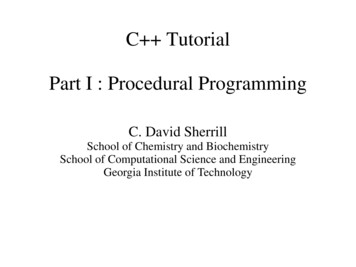

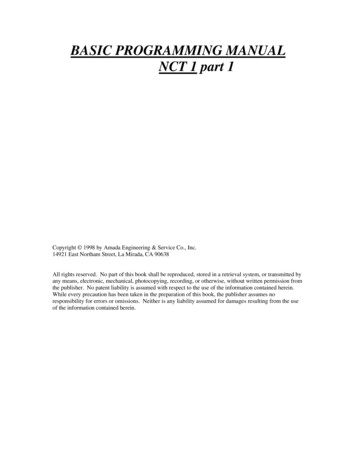
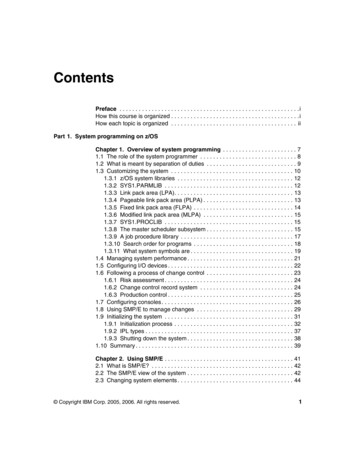


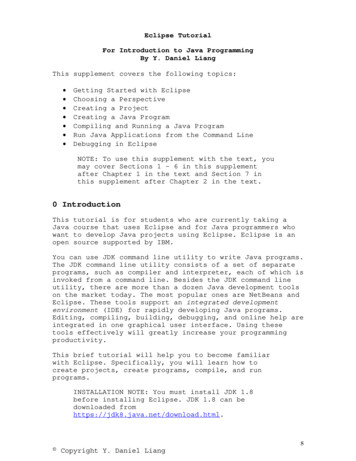
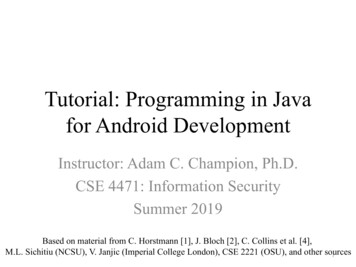


![Unreal Engine 4 Tutorial Blueprint Tutorial [1] Basic .](/img/5/ue4-blueprints-tutorial-2018.jpg)
